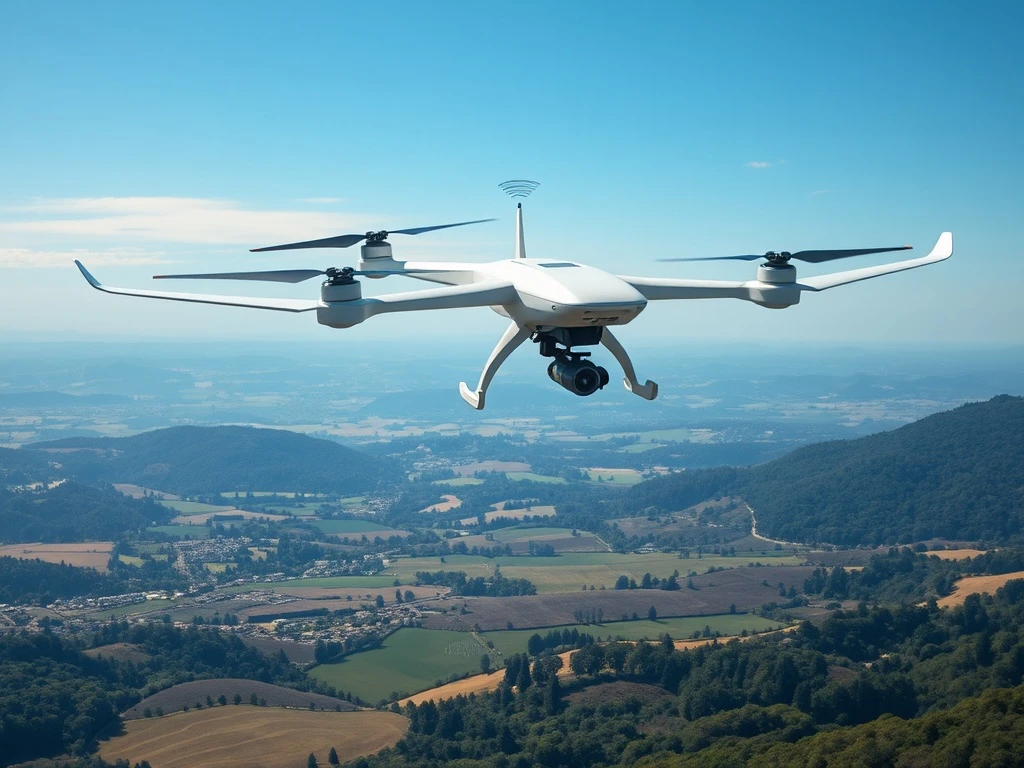The digital divide remains a significant global challenge. Millions worldwide lack reliable internet access. However, a groundbreaking initiative by World Mobile aims to change this landscape. This project introduces a drone-based, decentralized telecommunication system. It leverages advanced technology to deliver wireless services directly to users. Entrepreneurs and businesses should note this innovative approach to market expansion.
World Mobile Redefines Global Connectivity
World Mobile is launching a pioneering blockchain-enabled 5G network. This innovative system uses drones to beam connectivity worldwide. It partners with Protelindo, an Indonesian telecom company. The project specifically addresses gaps left by traditional communication infrastructure globally. This is a bold step towards universal access. Consequently, it opens new market opportunities in underserved regions.
The project employs hydrogen-powered drones. These aircraft fly at an impressive 60,000 feet in the stratosphere. Each drone provides wireless coverage for up to 15,000 square kilometers. Furthermore, it uses 450 guidable beams. Charles Barnett, Chief Business Officer of World Mobile Group, confirmed these details to StockPil. This aerial network significantly outperforms satellite-based telecommunications. It boasts a total latency of just 6ms. Consequently, it offers service up to 18 times cheaper per gigabyte than space-based infrastructure, Barnett stated. This makes the World Mobile solution highly competitive for global deployment.
The sky-based telecom industry is a massive sector. It is valued at $98.3 billion. This includes both satellite and aerial-based communication platforms. The satellite communications market alone is expected to swell to $159 billion by 2030. Source: Grand View Research. World Mobile seeks to capture a significant portion of this growing market. Its innovative approach positions it uniquely. It targets regions where traditional infrastructure falls short. Moreover, it provides a cost-effective alternative to satellite solutions. This strategic focus is crucial for market penetration.
The Engineering Marvel Behind World Mobile Stratospheric
Launching and maintaining a stratospheric communication platform presents complex challenges. Barnett highlighted these technical and regulatory hurdles. Each hydrogen-powered drone is substantial. It features a 56-meter wingspan. It also weighs four tons. The company aims for these aircraft to remain airborne for nine days. Afterward, they must land at a designated refueling station. Therefore, the craft and its fuel source must be exceptionally light. This ensures maximum fuel efficiency. It also allows for extended flight duration. Simultaneously, robust construction is essential. This protects the drone from harsh weather conditions at lower altitudes.
An image of the hydrogen-powered drones launched by World Mobile Stratospheric. Source: World Mobile Stratospheric
At 60,000 feet, the drones operate above most weather systems. The stratosphere also offers calmer winds. This reduces turbulence, a common issue at lower altitudes. However, unique environmental factors persist. Drones in the stratosphere must be shielded from cosmic radiation. This radiation can severely damage electronic equipment. Similarly, the side of the drone facing the sun experiences intense heat. This heat requires efficient displacement. Otherwise, it could cause significant damage to the aircraft’s systems. Designing for these extremes demands advanced engineering and material science.
The technical ingenuity extends to the power source. Hydrogen fuel offers a clean and efficient energy solution. It enables the long flight times necessary for sustained coverage. Furthermore, the design of the guidable beams is critical. These beams allow for precise targeting of coverage areas. This adaptability is vital for serving dynamic user populations. Consequently, World Mobile can optimize signal strength where it is most needed. This ensures reliable service even in challenging environments. The focus on efficiency and durability underscores the project’s long-term vision.
Navigating Regulatory Skies for Decentralized Telecom
Meeting regulatory requirements is another significant challenge. Civil aviation authorities impose strict standards. These include organizations like the Federal Aviation Administration (FAA) in the United States. The European Aviation Safety Agency (EASA) also sets rigorous guidelines. Acquiring permits to fly unmanned aerial vehicles (UAVs) is a complex process. Each drone must meet specific construction standards. Government aviation agencies outline these precise specifications. Compliance ensures safety and air traffic integration. Therefore, World Mobile invests heavily in regulatory adherence, working closely with authorities.
The regulatory landscape for stratospheric operations is still evolving. This adds another layer of complexity. International agreements may also become necessary. These would govern cross-border flights and spectrum allocation. Furthermore, privacy concerns arise with widespread aerial surveillance capabilities. Companies must address these issues transparently. Building trust with regulators and the public is paramount. This proactive approach helps secure long-term operational viability. Ultimately, regulatory approval is crucial for widespread deployment. Without it, expansion would be impossible.
The company’s commitment to these standards is unwavering. They work closely with authorities. This collaboration helps shape future aviation policies for high-altitude platforms. Such engagement fosters innovation responsibly. It also paves the way for a new era of aerial communication. Consequently, World Mobile is not just building technology. It is also helping define the framework for its safe and effective use. This foresight is key to its success. It demonstrates a holistic approach to market entry.
World Mobile in the Competitive Landscape
World Mobile faces competition from various angles. Both decentralized wireless networks and space-based communication platforms vie for market share. For instance, Helium Mobile operates as a decentralized protocol. It combines a distributed network of wireless nodes. It also partners with established telecom companies like AT&T. This extends wireless coverage. It also provides service to dead zones. Helium Mobile represents a significant player in the DePIN space, showcasing a different model for decentralized wireless.
Elon Musk’s Starlink also competes for market share. Starlink provides internet connectivity through a vast constellation of satellites. However, the two companies fill different niches, Barnett explained. Starlink primarily serves remote areas. These locations often lack any cellular connectivity. Conversely, World Mobile Stratospheric targets areas with higher densities of mobile users. The satellite communication platform also requires users to purchase dedicated hardware for connectivity, Barnett noted. This difference in user acquisition and target market is crucial for understanding their respective strategies.
[img id=”attachment_24565″ align=”aligncenter” width=”640″]
A Falcon 9 SpaceX rocket launches Starlink satellites into orbit. Source: SpaceX
[/img]
The distinction between these services is clear. Starlink excels in vast, unpopulated regions. It brings basic internet where none existed. World Mobile, however, optimizes for denser populations. It enhances existing cellular networks. It fills in gaps efficiently and affordably. This strategic positioning allows both companies to thrive. They serve distinct segments of the global connectivity market. Moreover, World Mobile’s DePIN approach offers a unique economic model. It incentivizes community participation. This further differentiates it from traditional and satellite competitors. It also aligns with the broader decentralization trend.
The Promise of World Mobile’s Decentralized Future
World Mobile has already established a ground-based decentralized physical infrastructure network (DePIN). This network blends traditional telecom infrastructure with independent, distributed providers. It extends service to underserved communities. It effectively patches dead zones. This hybrid model showcases the power of decentralization. It enables a more resilient and accessible network. Furthermore, it empowers local communities. They can participate in network provision. This creates a truly distributed system, reducing reliance on single points of failure.
The integration of blockchain technology is fundamental to World Mobile’s vision. Blockchain ensures transparency and security. It facilitates micro-transactions for services. It also manages the decentralized network of nodes and users. This technology enables a fair and efficient ecosystem. Participants are incentivized to contribute. This drives network expansion. Consequently, the project aims to create a truly global, community-owned network. This contrasts sharply with centralized telecom giants. It represents a paradigm shift in how connectivity is delivered and managed.
Ultimately, World Mobile’s drone-based initiative represents a significant leap forward. It addresses the persistent challenge of global connectivity. By combining cutting-edge aerial technology with decentralized principles, it offers a scalable and cost-effective solution. This project has the potential to transform lives. It can bring digital inclusion to millions. It also sets a new standard for future telecommunication infrastructure. The journey is complex, but the promise is immense. It offers a blueprint for a more connected world.
Frequently Asked Questions (FAQs)
What is World Mobile’s primary goal?
World Mobile’s main goal is to bridge the global digital divide. It aims to provide affordable and reliable internet connectivity to underserved communities worldwide. It achieves this through a unique blend of drone-based technology and decentralized network infrastructure.
How do World Mobile’s drones provide internet service?
World Mobile uses hydrogen-powered drones flying in the stratosphere at 60,000 feet. These drones are equipped with 450 guidable beams. They can provide wireless coverage over a vast area, beaming connectivity directly to users below. This high-altitude approach offers advantages over ground-based and satellite solutions by reducing latency and cost.
What makes World Mobile’s network ‘decentralized’ and ‘blockchain-enabled’?
The network is decentralized because it combines traditional telecom infrastructure with independent, distributed providers, forming a DePIN. Blockchain technology underpins this. It manages transactions, ensures network security, and incentivizes community participation in building and maintaining the network, making it more resilient and community-owned.
How does World Mobile compare to Starlink?
World Mobile and Starlink serve different niches. Starlink provides internet via satellites, primarily targeting remote areas without existing cellular connectivity. World Mobile, conversely, focuses on higher-density areas, enhancing existing cellular networks and filling coverage gaps with its drone-based system. World Mobile also aims for a more cost-effective per-gigabyte service and does not require dedicated user hardware.
What are the main challenges World Mobile faces?
World Mobile faces significant technical and regulatory challenges. Technical hurdles include designing lightweight, robust drones for long flight durations, managing cosmic radiation, and heat at stratospheric altitudes. Regulatory challenges involve obtaining permits from aviation authorities like the FAA and EASA, and adhering to strict aviation standards for UAV operations.
How does World Mobile’s project benefit users and entrepreneurs?
For users, it offers cheaper, more reliable internet access in previously underserved areas. For entrepreneurs, the decentralized model allows for participation in network provision, creating new economic opportunities. It also fosters innovation in last-mile connectivity solutions and potentially opens new markets for digital services.






















